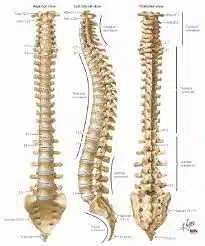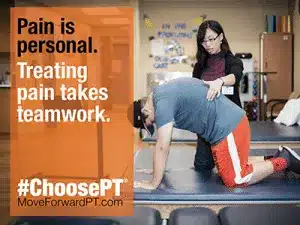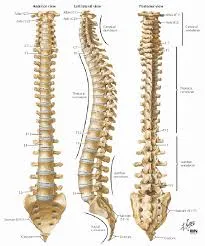The spine is composed of 33 vertebrae divided into five sections (cervical, thoracic, lumbar, sacral, coccygeal). Each section of vertebrae has a slight curve and a different shape. The cervical (neck) and lumbar (low back) vertebrae curve inwards, like a “C,” known as a lordotic curve. The thoracic (chest) vertebrae curve outwards, known as a kyphotic curve. Scoliosis, another spinal curve, occurs when the vertebrae move sideways, or laterally.

Each vertebrae has a hole in the center, called the vertebral foramen, through which the spinal cord passes. Between each vertebrae are intervertebral discs, which allow you to move and bend. Low back pain can be the result of disc displacement, narrowing of the openings where the nerves exit the spine, weakness or spasm of the muscles surrounding the spinal column, or compression on any of the pain sensitive structures around the spine.
There are some common diagnoses that we, as physical therapists, see frequently in the clinic. Spinal stenosis refers to the narrowing of the spinal canal which pushes on a nerve, resulting in pain. Spondylosis is a form of arthritis in the spine and can affect the joints between the vertebrae, and sometimes put pressure on the nerves. Spondylolisthesis occurs when one vertebrae moves anteriorly, or forwards. Vertebral stress fractures may occur with these two conditions. Spinal instability is closely related to spondylosis, and refers to the loss of control of the lumbar spine. Herniated discs occur when there is too much pressure on one part of the disc, usually the front part, which forces the disc material outwards. The discs in your spine have a firm outside with a jelly-like material inside; there are varying degrees of how much of this material is outside of the disc, or herniated.
When you come to physical therapy for your low back pain initial evaluation, your therapist will ask you a variety of questions in order to determine exactly which structures are involved and which therapeutic exercises will be of most benefit. You may be asked to provide information about the onset and duration of symptoms, if any positions aggravate or improve your pain, and if you have any particular goals for therapy, amongst other questions. While physical therapy will not fix any structural impairments, treatment is focused on general strengthening of muscles surrounding the affected area to reduce pain, improve posture, and improve overall quality of life. These muscle groups include, but are not limited to, the quadriceps and hamstrings in the leg, abdominal muscles (transverse abdominis, obliques), back (trapezius, latissimus dorsi), and the glutes. Your therapist may also implement a stretching routine, or nerve glides, which aim to reduce tension on a specific nerve by moving the body through a specific range of motion. Manual therapy interventions, such as soft tissue massage and joint mobilizations may be included depending upon the case, to improve the motion between joints, reduce muscle guarding, and improve overall motion. As always, it is important to be open and honest with your physical therapist so that you will receive the best and most accurate care for your condition.

Aly May, PT, DPT and Rachel Einhorn, Rehabilitation Aide



